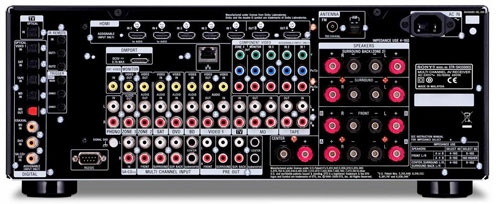Test Report: Sony STR-DA4600ES A/V Receiver Page 2

PERFORMANCE
I expect any 100-watts-plus A/V receiver these days to provide generous real-world power, and the Sony met this expectation without apparent effort. Close 2-channel, full-range listening revealed clean, dynamic sound at quite high levels. For example, when heard on my moderately low-sensitivity long-term speakers, a solo Brahms set by the incomparable pianist Richard Goode (on an Elektra/Nonesuch CD) sounded meaty and round, yet squeaky-clean, even at page-turner volume — that is, what you’d hear sitting on the bench next to the player. Even the two-fisted Rhapsody No. 4, in E-fl at (Op. 119), sounded clear, marvelously articulated, and convincingly Steinway.
I’m a fan of Dolby PLIIz’s height channels (and also those of Audyssey’s DSX). Playing the same recording via PLIIz produced a quite believable feeling of listening live in the great man’s own studio. The height contribution was decidedly subtle and almost perfectly inaudible as height per se, but the totality of the effect was impressively natural, especially on well-crafted acoustic classical and jazz recordings. (Solo piano reveals synthetic-sounding surround as well as any music.) Point is, on the Goode recording and also on the multichannel SACDs I listened to, the Sony impressed me with its solid, clean, dynamic amplifi cation services.
I also auditioned Loud, the guitar documentary featuring Jimmy Page, The Edge, and Jack White. The Sony, reproducing the transparent and involving DTS-HD Master Audio soundtrack, did its part to help make the film sonically compelling and a certain amount of fun.
The DA4600ES’s video processing includes upconversion of incoming analog composite- and component- video signals for 1080p output over HDMI. (Signals arriving via HDMI are a strictly a what-comesin- goes-out affair.) This worked well, though I occasionally saw some slight moiré artifacts on moving diagonal lines. Additionally, the Sony’s conversion of analog signals for HDMI output seemed to reduce picture detail very slightly.
Unusually, the Sony can also (and simultaneously) upscale a component-video source to 720p or 1080i format for its Zone 2 component-video output. Even more unusually, this output is routed through both a conventional component-video connection and an RJ-45 (Ethernet-type) jack ready to connect to Sony’s CAV-CVB1 HD-component balun — about $75 from online vendors. (A search of Sony’s own main Web site for information regarding this product turned up nothing. Big companies: Gotta love ’em.) Of course, the DA4600ES also has a plain ol’ composite-video output for Zone 2 video.
The DA4600ES is the first Sony I’ve used with full networking capabilities. Sony certifies the DA4600ES as DLNA-compatible in Windows environments, via Windows Media Player’s media-sharing functions or compatible servers. Since my media world is Macbased, I cannot comment on this, but I can say that the receiver worked reasonably well with Twonky Media, a DLNA-compatible Mac OSX/ Linux server. (There’s also a Windows version.) However, the Sony is not compatible with Apple lossless, FLAC, or video formats other than MPEG-2 and WMV. Also, iTunes — at least, iTunes on a Mac — seemed to confuse it: I needed to restart both my computer and the receiver before the DA4600ES’s Server page would recognize content. On the plus side, the Sony’s onscreen serveraccess menus scroll much faster than many I’ve used, making file selection quicker. Still, as with so many other network-capable receivers, there’s no search or indexing feature, and scrolling through long alphabetic lists, even those divided up by artists or albums, can be quite tiresome.
Finally, the DA4600ES doesn’t just have an Ethernet jack for a home network connection; it has four Ethernet jacks. The Sony incorporates a four-port Ethernet hub so that in our increasingly networked A/V world, you needn’t scare up an external Ethernet switch to connect the receiver and your networked TV and your networked Blu-ray player. Very thoughtful!
- Log in or register to post comments




















































